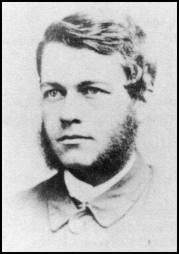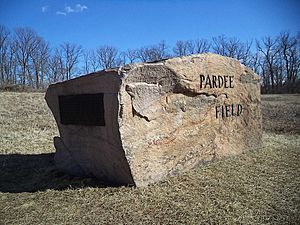Ario Pardee Jr. facts for kids
Quick facts for kids
Ariovistus Pardee Jr.
|
|
|---|---|
 |
|
| Born | October 28, 1839 Hazleton, Pennsylvania |
| Died | March 16, 1901 (aged 61) Wyncote, Pennsylvania |
| Buried |
St. Paul’s Episcopal Church, Elkins Park, Pennsylvania
|
| Allegiance | United States of America Union |
| Service/ |
United States Army Union Army |
| Years of service | 1861 – 1865 |
| Rank | |
| Unit | 28th Pennsylvania Infantry |
| Commands held | 147th Pennsylvania Infantry 1st Brigade, 1st Div., XX Corps |
| Battles/wars | American Civil War |
Ariovistus Pardee Jr. (born October 28, 1839, died March 16, 1901) was a brave officer. He served in the Union Army during the American Civil War. He became well-known during the Battle of Gettysburg. There, he helped defend a part of Culp's Hill on July 3, 1863. A special monument on the Gettysburg Battlefield marks this spot. It is known as "Pardee Field."
Contents
Who Was Ario Pardee Jr.?
His Early Life and Family
Ario Pardee Jr. was the oldest child of Ariovistus Pardee. His father was a wealthy businessman who helped start Hazleton, Pennsylvania. Ario Jr. was born in Hazleton on October 28, 1839. His mother, Elizabeth Jacobs, passed away when he was young.
He studied to become a civil engineer at Rensselaer Polytechnic Institute. After finishing school in 1858, he worked in his father's coal mines. These mines dug up anthracite coal, a type of hard coal. Before the war began, he married Mary Allison. Sadly, their only child was stillborn during the Civil War. Ario Pardee Jr. had no other children.
Serving in the Civil War
Joining the Union Army
Pardee joined the 28th Pennsylvania Infantry on June 28, 1861. This was at the start of the Civil War. He began as a captain in Company A. Later, on November 1, he was promoted to major. He served under General John W. Geary.
Pardee fought in the Shenandoah Valley campaign. He was part of General Nathaniel Banks' command. This group faced Confederate General Stonewall Jackson. Pardee thought his commander, Geary, was too careful. He believed they could have held their ground better.
Battles in the East
As a major, Pardee led his regiment at the Battle of Antietam. This battle happened on September 17, 1862. His horse was shot from under him, but he was not hurt. General George S. Greene praised Pardee for his bravery. Pardee even briefly took command of his brigade.
Soon after, Pardee became a lieutenant colonel. He took command of a new regiment, the 147th Pennsylvania Infantry. His next big fight was the Battle of Chancellorsville. He led his regiment there.
He also led his regiment at the Battle of Gettysburg. This was a very important battle. On July 2 and 3, 1863, Pardee fought on Culp's Hill. A part of Culp's Hill is now named "Pardee Field" in his honor. His regiment, the 147th Pennsylvania, defended this area. They faced strong attacks from Confederate troops. Pardee was told to keep firing steadily. This helped push back the Confederate attacks.
Moving West with the Army
Pardee's corps, the XII Corps, was later sent west. They went to help the Army of the Cumberland in Chattanooga, Tennessee. This army was surrounded by Confederate forces. Pardee's regiment fought in several battles in the west. These included the Battle of Wauhatchie, the Battle of Lookout Mountain, and the Battle of Ringgold Gap. He even praised General Geary's actions during the Battle of Wauhatchie.
On March 19, 1864, Pardee was promoted to colonel. He then led his regiment in the XX Corps. This corps was part of General William T. Sherman's Atlanta Campaign. At the Battle of Peachtree Creek, Pardee's regiment held its position. Other regiments around them had to retreat. The 147th suffered many losses in this battle.
Later in the war, Pardee often led the First Brigade of Geary's Division. He was part of Sherman's famous March to the Sea. He also fought in the Carolinas Campaign. His last major battle as a brigade commander was the Battle of Bentonville in North Carolina.
Pardee was promoted to the honorary rank of brevet brigadier general. This was on January 12, 1865, for his bravery at Peachtree Creek. He left the army on June 13, 1865.
Life After the War
After the Civil War, Pardee went back to Pennsylvania. He returned to the coal business. He worked with his father and his brother, Calvin. However, Ario Jr. was not deeply involved in managing the businesses. His health seemed to have been affected by his time in the war.
He also had interests in railroads. He was a member of the Military Order of the Loyal Legion of the United States. His wife, Mary Pardee, passed away before him. Ario Pardee Jr. died in Wyncote, Pennsylvania, on March 16, 1901. He was buried in the churchyard of St. Paul’s Episcopal Church. This church is in Elkins Park, Pennsylvania.



